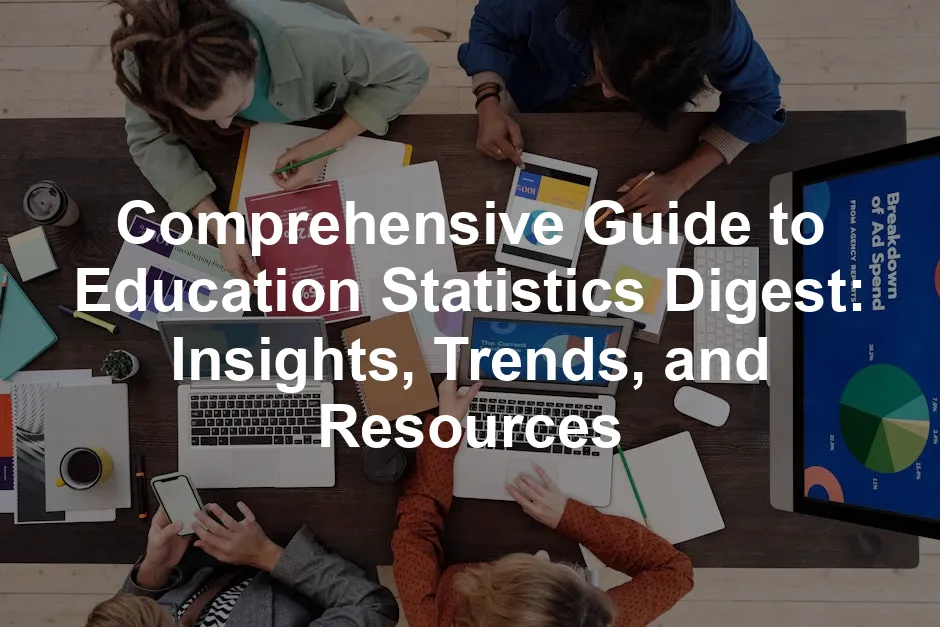Introduction
Education statistics play a crucial role in shaping policies and understanding trends within the education sector. These statistics help guide decisions that affect educational systems, funding, and overall effectiveness. They answer vital questions: Are students meeting benchmarks? What areas need improvement? This numerical insight can spark significant changes in teaching methods and resource allocation.
An “Education Statistics Digest” is a compilation of key statistics and analyses that reflect the state of education over time. It provides a snapshot of various aspects of education, from enrollment numbers to funding levels. These digests serve different contexts, with the U.S. focusing on its unique educational landscape, while international versions address global trends.
Several authoritative sources provide this data, with the National Center for Education Statistics (NCES) leading the way in the U.S. They gather data from numerous surveys and reports, creating a comprehensive picture of education across the country. Other educational bodies globally, like Singapore’s Ministry of Education, also produce similar statistical resources.
This article aims to offer a thorough digest of education statistics. We will cover key indicators, emerging trends, and valuable resources to help educators, policymakers, and researchers make informed decisions. Whether you are in the U.S. or abroad, understanding these statistics is essential for driving educational success.

The Importance of Education Statistics
The Role of Education Statistics in Policy Making
Statistical data significantly influences educational policy decisions. Policymakers rely on these numbers to determine funding allocations and identify areas requiring improvement. For instance, federal education funding often hinges on enrollment figures, dropout rates, and student performance metrics. Accurate statistics help ensure that resources are directed where they are needed most, ultimately enhancing educational quality.
If you want to dive deeper into how data can transform education, check out “How to Measure Anything: Finding the Value of ‘Intangibles’ in Business” by Douglas W. Hubbard. This book reveals how quantifying the unquantifiable can lead to better decision-making.
Understanding Educational Trends through Statistics
Data trends offer insights into future educational needs. For example, tracking enrollment trends over the years helps predict potential classroom shortages or surpluses. If more students are enrolling in STEM programs, schools might consider expanding their science and technology offerings. Identifying these trends early allows for proactive measures, ensuring that educational institutions can adapt and evolve with changing demands.
To better understand the statistical methods behind these trends, I recommend “The Data Warehouse Toolkit: The Definitive Guide to Dimensional Modeling” by Ralph Kimball. This book is essential for anyone looking to understand data organization and analysis.
The Global Context of Education Statistics
The use of education statistics varies across countries. In the U.S., statistics primarily focus on K-12 and higher education, while Singapore’s statistics include detailed data on pre-university and post-secondary education. For nations like Trinidad and Tobago, education statistics help monitor progress towards international and regional development goals. Global statistics enable countries to benchmark their educational progress against one another, fostering a culture of accountability and continuous improvement.
In conclusion, education statistics play an indispensable role in policymaking, trend analysis, and global comparisons. By understanding these statistics, stakeholders can drive improvements and innovations in the education sector, ensuring better outcomes for all learners.

Overview of Key Education Statistics Digests
United States: Digest of Education Statistics
The Digest of Education Statistics is a treasure trove of information, published by the National Center for Education Statistics (NCES). This annual compilation provides a detailed overview of education in the U.S., covering everything from prekindergarten to graduate school. It draws on myriad sources, ensuring a comprehensive snapshot of the educational landscape.
Key topics in the Digest include the number of schools and colleges, teacher statistics, enrollments, graduates, and educational attainment. It also dives into financial aspects, detailing federal funds allocated for education and expenditures at various levels.
The latest edition, released in early 2024, showcases trends that reveal both progress and challenges within the U.S. education system. For instance, the number of public schools has steadily increased, yet challenges like teacher shortages persist. Furthermore, the report highlights a slight rise in overall graduation rates, indicating improvements in student retention and achievement.

This year’s statistics also spotlight issues such as the digital divide, where access to technology varies significantly across socio-economic groups. These insights offer educators and policymakers a roadmap for addressing disparities and enhancing educational quality.
For a deeper understanding of the statistical frameworks used in education, refer to the statistics for the behavioral sciences.
Singapore: Education Statistics Digest (ESD)
Singapore’s Education Statistics Digest (ESD) stands as a model of clarity and insight. This digest is structured into three sections, making it easy for readers to find relevant data. The first section focuses on primary, secondary, and pre-university education statistics. Here, readers can explore enrollment figures and teacher statistics, providing a foundation for understanding the educational framework.
The second section delves into post-secondary education, covering institutions like polytechnics and universities. Statistics here include enrollment rates and graduates, essential for evaluating the effectiveness of higher education institutions.
Lastly, the ESD offers a historical perspective through its third section, presenting time series data on key educational indicators. This adds context to the current statistics, allowing for a better understanding of trends over time.
Additionally, the ESD provides valuable insights into employment outcomes post-education. Data on job placement rates and financial earnings reflect the effectiveness of Singapore’s education system in preparing students for the workforce.

Trinidad and Tobago: Education Statistics Digest
The Education Statistics Digest from Trinidad and Tobago is a vital resource for understanding the local education landscape. This digest encompasses a variety of educational data, focusing on enrollment figures, dropout rates, and overall educational outcomes.
One of the highlights from the latest edition includes a detailed analysis of enrollment trends across primary and secondary schools. It reveals fluctuations that correlate with population changes, which can influence future educational planning and resource allocation.
Additionally, the digest addresses dropout rates, providing crucial insights into potential barriers faced by students. By analyzing these statistics, stakeholders can better understand the challenges within the education system and devise strategies to enhance student retention.
The publication also examines educational outcomes, showcasing performance metrics from national examinations. This data is invaluable for educators aiming to improve teaching strategies and curricula to better serve students.

OECS Education Statistical Digest
The OECS Education Statistical Digest serves as a pivotal resource for the Eastern Caribbean region. It encompasses a wide scope, collecting education data from multiple member states. This digest is essential for regional educational planning and policy-making.
Key indicators featured in the digest include enrollment figures across various educational levels, from primary to tertiary institutions. It also addresses the efficiency of education systems by analyzing data on student retention and graduation rates.
Another significant aspect of the OECS digest is its focus on access to data. By providing comparative statistics among member states, it fosters a sense of accountability and encourages best practices across the region.
The information within the OECS digest is crucial for policymakers and educators. It enables them to identify trends, allocate resources effectively, and improve educational outcomes for all students across the member states.

Key Metrics and Trends in Education Statistics
Enrollment and Graduation Rates
Enrollment trends in education provide a glimpse into how many students are stepping into classrooms each year. In the U.S., the latest data shows a steady increase in K-12 enrollments, with 50.7 million students enrolled in public schools for the 2022-2023 academic year. This marks a slight rebound from the pandemic-induced drop in enrollments. Interestingly, pre-kindergarten enrollments have surged, emphasizing the growing recognition of early childhood education’s importance.
Graduation rates tell a different story. The national high school graduation rate has reached an impressive 86%, but disparities remain stark. For instance, graduation rates vary significantly across racial and ethnic groups. The rate for White students stands at around 89%, while Black and Hispanic students graduate at rates of 80% and 82%, respectively. This gap highlights the ongoing challenges in educational equity and the need for targeted interventions to support underrepresented groups.

In higher education, trends reveal that more students are pursuing degrees. The college enrollment rate reached 66% for recent high school graduates. However, the graduation rates for four-year institutions tell a more complex tale, with only about 62% of students completing their degree within six years. Factors such as socioeconomic status and first-generation college status play a significant role in students’ likelihood of graduating.
To better grasp the underlying principles of statistics that drive these trends, consider reading “Statistics for Dummies” by Deborah J. Rumsey. It’s a great way to demystify the numbers and make sense of the data.
Teacher Statistics
The teaching workforce is crucial in shaping educational outcomes. As of the latest estimates, there are approximately 3.2 million teachers in U.S. public schools. However, the teacher shortage crisis looms large. Many districts report difficulty filling positions, particularly in specialized subjects like math and science. A staggering 20% of schools indicated they faced challenges in hiring qualified teachers this year.
Diving deeper into teacher qualifications, around 94% of public school teachers hold at least a bachelor’s degree. Yet, only about 60% possess a master’s degree or higher. Teacher pay is another critical issue. The average salary for public school teachers was approximately $63,000, which, while competitive, still does not match the rising cost of living in many areas. This discrepancy affects teacher retention and job satisfaction.

The teacher labor market is also influenced by turnover rates, which hover around 8%. This rate can be especially high in low-income urban schools. Addressing these challenges requires innovative recruitment strategies and improved working conditions to ensure that classrooms are staffed with passionate educators.
Educational Attainment and Outcomes
Educational attainment in the U.S. continues to rise, with over 90% of adults holding at least a high school diploma. However, the statistics become more nuanced when examining college degrees. Currently, about 38% of adults over 25 possess a bachelor’s degree, a figure that has steadily climbed over the past decade. Internationally, the U.S. ranks among the top countries for educational attainment but still trails behind nations like Canada and Japan.
The outcomes of education are closely tied to employment rates and income levels. College graduates earn, on average, over $1 million more in their lifetimes than those with only a high school diploma. This stark difference underscores the financial benefits of higher education. However, student debt remains a significant concern, with borrowers owing an average of $30,000 upon graduation.

Globally, educational outcomes vary widely. Countries with strong vocational training systems, like Germany, report lower youth unemployment rates compared to those that emphasize traditional university pathways. This suggests that diversifying educational offerings could enhance employment opportunities for students.
Financial Aspects of Education
Funding for education remains a hot topic. In the U.S., total public education funding reached nearly $800 billion in 2021. Federal funding accounts for about 8% of this total, with states and local governments providing the majority. However, disparities in funding persist, with wealthier districts often receiving substantially more than underfunded areas.
Trends in educational spending indicate a shift towards increasing investment in mental health resources and technology integration in classrooms. Schools are now allocating more funds to support students’ social and emotional needs, recognizing that academic success is intertwined with overall well-being.
The impact of educational funding on outcomes is significant. Research shows that increased spending per pupil correlates with improved student performance, particularly in low-income districts. As policymakers continue to debate the best strategies for funding education, ensuring equitable distribution of resources will be vital for closing achievement gaps and fostering a more inclusive educational landscape.

In summary, education statistics reveal crucial insights into enrollment, graduation rates, teacher dynamics, educational outcomes, and financial aspects of education. These metrics not only inform policy but also guide educators and stakeholders toward effective strategies for improvement. Understanding these trends equips all involved in education to navigate the evolving landscape and meet the needs of diverse learners.
Accessing and Utilizing Education Statistics
Where to Find Education Statistics
Finding reliable education statistics can feel like searching for a needle in a haystack. Fear not! Here are some key resources to help you locate that precious data:
- National Center for Education Statistics (NCES): This is the go-to source for U.S. education data. They publish the Digest of Education Statistics, which compiles a wealth of information on everything from school numbers to graduation rates. You can access their latest reports and tables here.
- Ministry of Education Publications: Many countries have their own Ministry of Education that publishes annual statistical digests. For instance, Singapore’s Education Statistics Digest (ESD) includes detailed data on schools, enrollment, teachers, and employment outcomes. Access Singapore’s ESD here.
- OECS Education Statistical Digest: This digest provides valuable insights into the education systems of various Eastern Caribbean nations. It includes essential statistics on enrollment, retention, and financial data. You can explore the OECS Digest here.
- Local Libraries and Databases: Many regional and state libraries offer access to educational databases and reports. For example, the Connecticut State Library provides resources for federal and state education statistics. Check out their guide here.
- International Organizations: UNESCO and the World Bank also publish education statistics that can provide a global perspective. Their databases include invaluable data on educational attainment and global trends.

To effectively access these resources, take advantage of their search features, and make sure to filter results based on your specific needs. Bookmark relevant pages for quick reference, and don’t hesitate to reach out to support teams if you hit a snag.
How to Interpret Education Statistics
Interpreting education statistics can be as tricky as solving a Rubik’s Cube blindfolded. Here are some tips to help you navigate this statistical maze:
- Understand the Context: Always consider the context in which the data was collected. Who conducted the survey? What was the sample size? These factors can drastically affect the results.
- Look for Trends: Single data points can be misleading. Always analyze trends over time to get a clearer picture. For example, a sudden spike in enrollment might indicate a temporary surge rather than a lasting shift.
- Beware of Bias: Be cautious of statistics that paint an overly rosy picture. Look for data from multiple sources to verify claims. If something seems too good to be true, it probably is!
- Seek Out Definitions: Terminology can be confusing. Ensure you understand key terms and definitions used in the reports. This helps prevent misinterpretation.
- Visualize the Data: Graphs and charts can make complex information more digestible. Utilize visual aids to help clarify trends and comparisons.

Common pitfalls in data interpretation include failing to account for sampling bias, misinterpreting correlation as causation, and overlooking significant variables. Keep these in mind to avoid falling into the statistical trap.
Utilizing Statistics for Research and Policy Advocacy
Statistics are more than just numbers; they are powerful tools for driving change. Educators and policymakers can utilize education statistics to bolster research and advocacy efforts. Here’s how:
- Informing Research: Statistics provide the backbone for research studies. For example, data on graduation rates can help researchers investigate the factors contributing to student success or failure.
- Crafting Policy: Policymakers rely on accurate data to make informed decisions. For instance, if statistics reveal that certain schools suffer from high dropout rates, targeted interventions can be designed to address those issues.
- Successful Advocacy Examples: Numerous advocacy efforts have successfully leveraged data insights. A notable case is the push for increased funding in low-income districts. Advocates used enrollment and performance data to demonstrate the need for equitable funding, ultimately leading to policy changes.
- Collaboration and Communication: Educators and organizations can collaborate to share statistics and best practices. This collective approach can amplify voices and make a more significant impact.

In summary, education statistics are indispensable in shaping research and policy. By utilizing data effectively, stakeholders can enhance educational outcomes and drive meaningful change in the system. Whether you’re a researcher, educator, or policymaker, keep these insights close at hand!
Conclusion
Education statistics are more than just numbers; they are vital tools that shape policies and practices across educational systems. These statistics provide insights that inform decision-making, enabling policymakers to allocate resources effectively. They highlight areas in need of improvement and celebrate accomplishments, guiding the direction of education reforms.
Without accurate education statistics, we risk basing decisions on assumptions rather than facts. When data drives policy, it reflects the true state of education. For example, understanding dropout rates can lead to targeted interventions, ensuring students receive the necessary support to stay in school. This data-centric approach fosters an environment where educational quality is consistently improved.
However, the world of education is dynamic. Continuous research and data collection are essential to keep pace with changing educational landscapes. New challenges, like the rise of online learning, require fresh data to inform strategies. As we adapt to technological advancements and shifts in learning paradigms, maintaining an ongoing commitment to data collection is paramount.
All stakeholders—educators, administrators, and policymakers—must utilize existing resources to improve educational outcomes. Resources like the Digest of Education Statistics and other educational data repositories offer a wealth of information. They are invaluable for anyone looking to make informed decisions based on current trends and statistics. By engaging with these resources, stakeholders can shape a brighter future for education.
In summary, education statistics are essential for informed decision-making. They highlight successes and areas needing improvement while guiding policy and practice. As we look to the future, continued research and data collection will empower all involved in education to create environments where every learner can thrive.
FAQs
What is an Education Statistics Digest?
An Education Statistics Digest is a compilation of key statistical data related to the education sector. It serves as a comprehensive resource, providing insights into various aspects of education, such as enrollment figures, educational attainment, and financial data. The purpose of the digest is to present a clear overview of educational trends, challenges, and successes, enabling stakeholders to make informed decisions.
Where can I find the latest education statistics?
You can find the latest education statistics through several reputable sources: 1. National Center for Education Statistics (NCES): Their Digest of Education Statistics is an annual publication that compiles a vast array of education data in the U.S. 2. Singapore Ministry of Education: Their Education Statistics Digest provides crucial insights into Singapore’s education system. 3. OECS Education Statistical Digest: Access statistical information from various Eastern Caribbean nations through the OECS website. 4. Local Educational Institutions: Many universities and colleges publish their own statistics, which can be valuable for regional insights.
How can education statistics impact policy decisions?
Education statistics play a critical role in shaping effective educational policies. They provide evidence that guides decision-making, enabling policymakers to identify areas requiring intervention. For instance, if statistics indicate declining graduation rates in a particular district, targeted support can be allocated to address the issue. Data-driven policies enhance accountability and ensure resources are used where they are most needed.
Are there differences in education statistics between countries?
Absolutely! Education statistics can vary significantly across countries due to differences in educational systems, funding, and cultural contexts. For example, the U.S. primarily focuses on K-12 and higher education, while Singapore includes comprehensive data on pre-university and post-secondary education. Understanding these variations is essential for international comparisons and benchmarking educational progress.
How can I contribute to educational data collection?
Individuals can contribute to educational data collection in several ways: 1. Participating in Surveys: Many educational institutions conduct surveys to gather data on student experiences and outcomes. Participation can provide valuable insights. 2. Engaging in Local Initiatives: Join local educational programs or initiatives that focus on data collection and research. This can help identify community needs and improve educational practices. 3. Advocating for Data Transparency: Encourage educational institutions to share their data publicly, fostering a culture of transparency and informed decision-making.
Please let us know what you think about our content by leaving a comment down below!
Thank you for reading till here 🙂
Speaking of reading, if you’re looking for a great way to enjoy your next book, consider grabbing a Kindle Paperwhite. It’s perfect for enjoying your favorite reads, whether you’re on a beach, in a cozy chair, or just trying to escape reality for a bit.
All images from Pexels




